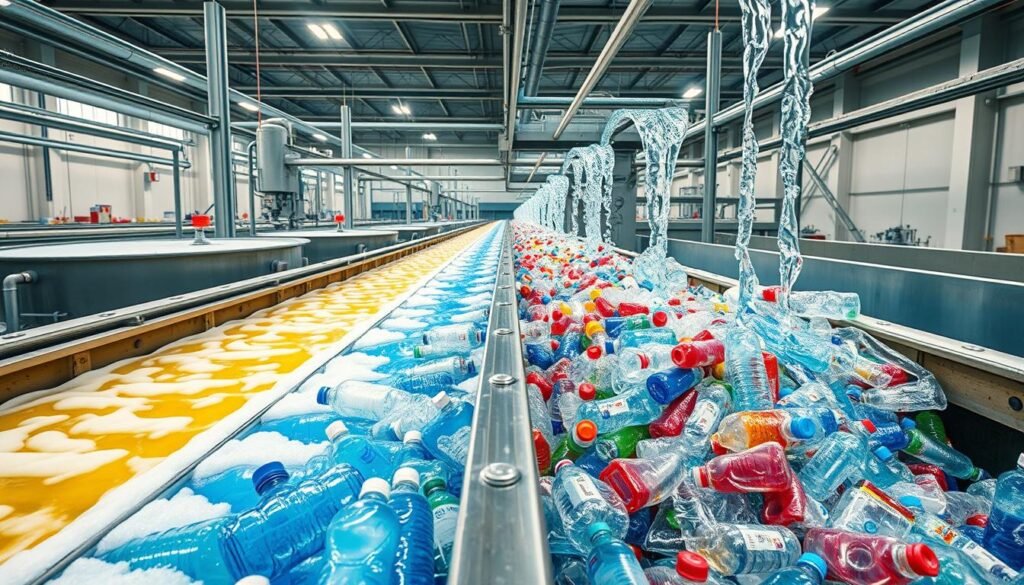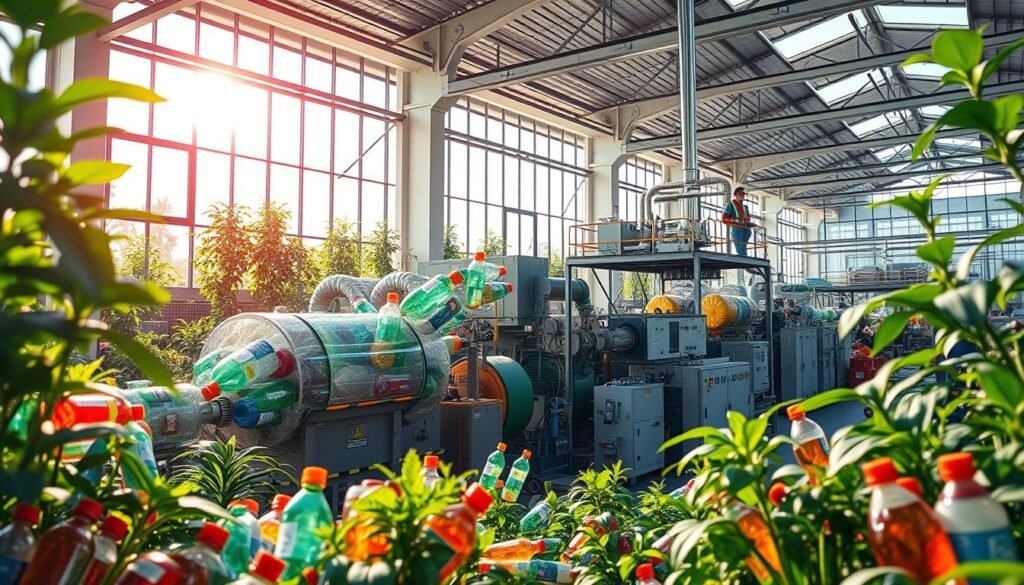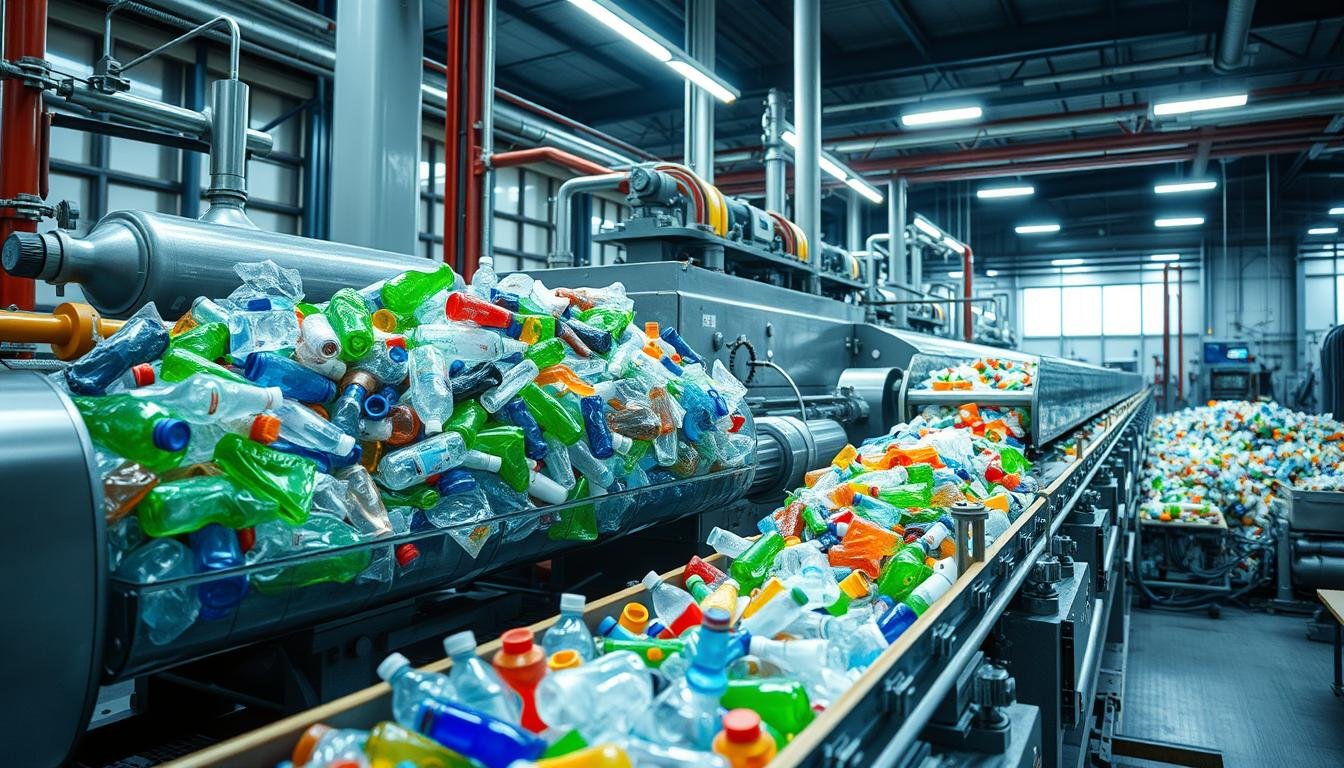Did you know the global plastic recycling market is set to hit $59.51 billion by 20271? This growth shows how more businesses and homes are recycling, tackling the plastic waste crisis and pushing for sustainability1. At the core, advanced plastic recycling machines and extrusion tech are changing how we handle and reuse plastic waste.
Plastic recycling starts with collecting plastic from various places, then sorting and reprocessing it at Material Recovery Facilities1. To sort plastics, we use many methods like manual picking and high-tech machines1. Washing the plastic next removes dirt, making sure the recycled material is top-notch1.
Then, the sorted and cleaned plastic gets turned into new plastic pellets through extrusion1. This process, along with shredding or grinding, is key to recycling plastic efficiently and on a large scale1. Working together, recycling teams make sure this process runs well1.
Key Takeaways
- Plastic recycling is booming, thanks to more people recycling to fight the plastic waste crisis.
- High-tech machines and processes like sorting, shredding, and extrusion are changing how we recycle and reuse plastic.
- Extrusion tech is key in recycling, turning plastic waste into new, useful materials.
- Working together, recycling teams make sure the recycling process works well.
- By using recycling machines and extrusion tech, we’re making our economy more sustainable and cutting down on carbon emissions.
Plastic Recycling’s Role in Sustainability
Plastic recycling is key to making our planet more sustainable. Only about 9% of plastic waste gets recycled worldwide. In the European Union, around 38% of plastic waste is recycled2. But, making plastic recyclable again is hard. JianTai is working on new ways to fix this.
Reducing Environmental Impact and Carbon Emissions
Mechanical recycling is vital for a green plastic economy3. Recycling plastic saves resources and uses less energy than making new plastic3. It also cuts down on carbon emissions. Companies that invest in recycling machines help the planet and stand out from others3.
Integrating Advanced Technologies for Efficiency
New tech is making plastic recycling better, greener, and more efficient2. Automated systems and new drying methods make recycling easier and cheaper4. Now, small recycling machines let even individuals and small businesses join in4.
“Working together is key to improving plastic recycling machines and using resources wisely.”2
Plastic recycling machines are key to a circular economy2. With new tech and teamwork, the recycling industry can lessen harm to the environment. It can also save resources and boost the economy2.
Plastics Extruders: Melting Plastic Flakes into New Products
Plastic extruders are key in recycling plastic, turning trash into new materials. Plastic recycling machines melt plastic flakes into shapes for new items. They remove moisture well, making recycled PET as good as new PET5.
JianTai makes plastic extruders for all kinds of businesses. They work with many plastics, like HDPE and ABS, making from 100 kg/h to 1000 kg/h6.
- The plastic granulator is 47 x 77 x 135 cm, weighs 140 kg, and needs 200-415 V, 50-60 Hz5.
- The desktop granulator is 58 x 34 x 68 cm, uses 100-415 V, 50-60 Hz5.
- The extruder is 77.5 x 36 x 103 cm, runs on 200-240 V, 50-60 Hz5.
JianTai’s machines save over 20% energy, making them a green choice6. With 20 years in the field, JianTai leads in recycled plastic production machinery6.
Plastic recycling machines are key to a green economy. They turn waste plastic into new items through melting and shaping6. Plastic recycling extrusion tech helps businesses make sustainable materials, helping our planet6.
“JianTai’s machines have turned hundreds of thousands of plastics into new products. This has created jobs and skills in our community.”
This shows how JianTai’s plastic extruders have made a big difference. They’ve made thousands of products, jobs, and skills, and reduced plastic waste7.
Shredders and Granulators: Breaking Down Bulky Plastics
Breaking down big plastic pieces is key in recycling plastic. Plastic shredders and granulators are vital. They turn big plastic items into smaller pieces. This makes them easier to handle and process next steps. It also saves energy and cuts down on carbon emissions8.
Types of Plastic Shredders
Plastic shredders use a tearing or shearing action to make materials smaller. They come in single-shaft and dual-shaft types, each for different plastics and needs9. Vecoplan makes over 300 shredder types for the plastics industry10.
Plastic Granulators
After shredding, plastic granulators make the pieces even smaller. They cut the plastic into uniform pieces or granules9. This step is key for recycling, getting the plastic ready for making pellets or extrusions8.
| Plastic Shredder Type | Key Features |
|---|---|
| VAZ Shredders | Designed for general heterogeneous scrap |
| VTH Shredders | Specialized for lineal scrap |
| FF Series Shredders | Tailored for film and fiber plastics |
| XL Shredders | Handling large bulky plastic materials |
| “Shorty” Shredders | Compact design for installations with limited space |
| VNZ Dual Shaft Shredders | Provide initial size reduction for large volumes of oversized plastic waste |
“Vecoplan has been a leader in size reduction technologies since 1969, specializing in industrial shredders for recycling all types of plastics.”10
Plastic shredders and granulators are key for recycling plastic today. They make big plastic pieces smaller. This makes recycling easier, uses less energy, and helps the environment8.
Plastic Washing Lines: Enhancing Recycled Material Quality
Keeping recycled plastics in good shape is key for making new products11. Washing lines help a lot by making plastic film recycling up to 50% more efficient11. This means making the recycling process faster and saving time11.
These systems also filter out over 95% of particles, keeping the water clean11. This clean water can be used again, saving a lot of water11.
Rigid Washing Line
Rigid plastics like containers and bottles need special cleaning to get rid of dirt and other stuff11. Rigid washing lines are made just for these plastics, cleaning them well for recycling11. They make recycling cheaper by cutting labor costs by up to 30%, making recycling more affordable11.
Film Washing Line
Thin plastics like bags and packaging are hard to recycle. Film washing lines are made just for these plastics, making sure they’re clean and ready for recycling11. After going through a film washing line, plastic film quality goes up by over 80%11. This makes it good for many uses, from packaging to building things11.
As more people want high-quality recycled plastics, the need for washing lines grows11. These systems make recycled materials better and help the planet by using less new plastic. This could cut down greenhouse gas emissions by 40% in plastic making11.

Additional Recycling Equipment
There’s more to plastic recycling than just the main machines. Specialized equipment like dryers, separators, pelletizers, conveyors, and melt filters are key. They work together to make recycling better and more efficient.
Dryers
Dryers are key in recycling plastic. They take out extra moisture before melting or extruding the plastic. This is important because moisture can ruin the recycled product and use more energy12.
Separators
Separators sort plastics by their size, shape, and other features. This makes sure different plastics are separated well. It helps make high-quality recycled materials12.
Pelletizers
Pelletizers change shredded plastic into uniform pellets. These pellets are easier to handle and transport. They make recycling easier for making new products12.
Conveyors for Recycling Machines
Conveyors help connect different recycling machines together. They make sure materials move smoothly through the recycling process. This makes recycling more efficient and productive12.
Melt Filters
Melt filters clean molten plastic before it’s used in making new products. They remove dirt and other unwanted stuff. This keeps the recycled plastic clean and ready for many uses12.
Using these special machines makes recycling better and helps the environment. It also makes sure recycled plastic is of high quality12.
“Our commitment to sustainability is reflected in the advanced plastic recycling equipment we provide, enabling our clients to maximize the value of their plastic waste streams.”
– John Smith, Chief Technology Officer, JianTai
The Plastic Recycling Process: An Overview
The plastic recycling process has many steps, from collecting to making new products13. First, plastic waste is picked up from homes, businesses, and recycling centers13. Then, it goes to Material Recovery Facilities (MRFs) and Plastic Recovery Facilities (PRFs) for sorting13.
Sorting uses machines like manual pickers and separators to sort plastics by type13. After sorting, the plastic is cleaned, shredded, and turned into pellets13. These pellets are sold to make new products, closing the loop13.
- Collection + Distribution
- Sorting + Categorizing
- Washing
- Shredding
- Identification and Separation of Plastics
- Extruding + Compounding
Knowing the recycling stages and plastic types is key to recycling well13. The recycling workflow turns plastic waste into valuable materials13. This helps the environment and supports a sustainable future13.
The plastic recycling process has many benefits but also challenges like awareness and contamination13. New technologies are helping to solve these problems and increase recycling rates14.
“Recycling plastic consumes 88% less energy compared to producing plastics from raw materials.”15
Understanding the plastic recycling process helps us make better choices for a sustainable economy13. By using the recycling workflow and new technologies, we can help the environment and our economy13.
Optimizing Plastic Recycling with Advanced Machinery
Plastic recycling is key for a clean planet and saving the environment. Advanced machines play a big part in making this happen. They make recycling plastics better and more efficient16. These machines help recycle plastics well, making the process smoother16.
They also make recycling safer and cut down on costs by doing some work on their own16. By using less energy and making less pollution, these machines help our planet too.
Each machine in the recycling process is important. Shredders and granulators chop plastic into smaller bits. Washers and dryers clean the plastic, getting it ready for making new things17. Extruders turn plastic back into a shape it can be used again, and separators sort plastics by how heavy they are.
17 Conveyors keep things moving smoothly in recycling places. Sorters use special tech to pick out different plastics, keeping the recycled stuff top-notch17. Keeping shredders and granulators in good shape makes them work better and last longer17. Getting materials ready right before recycling helps machines work better too.
17 Washing and drying plastics gets rid of dirt and water, making the recycled plastic better for new uses18. This machine works really well, making almost all plastic recyclable fast18. It can recycle a lot of plastic and uses less energy to do it.
Using advanced machines for recycling helps businesses work better and make better recycled products. It also cuts down on carbon emissions a lot16. These machines are good for the planet by reducing pollution, saving resources, and helping the economy go in a circle.
Bottle-to-Bottle PET Recycling: Closing the Loop
Plastic recycling faces a big challenge with PET bottles. Every year, over 82 million metric tons of PET plastic are made. A lot of this ends up in single-use bottles. PET bottle-to-bottle recycling is a key way to fix this and help the planet.
Challenges in PET Recycling
One big problem with PET recycling is getting rid of moisture in the PET flakes. This can make the recycled product not good enough19. CPM Extricom Extrusion has found a solution with their Twin Screw Extruders and RingExtruder RE®. These machines help remove moisture, making the recycled PET as good as new.
CPM Extricom Extrusion Solutions
CPM Extricom Extrusion leads in PET bottle recycling with their advanced technology. Their equipment tackles moisture and makes recycling a closed loop. This means old PET bottles can be turned into new ones, saving resources and cutting down on waste.
| Key Features | Specifications |
|---|---|
| Washing Process | BoReTech’s washing process is the only technology in Asia that has achieved USA FDA LNO (Letter of No Objection) standards19. |
| Input Capacity | BoReTech’s washing line ranges from 1500 to 3000 kg/h, while input capacity for SSP ranges from 900 to 2000 kg/h19. |
| Recycled Content | Global Consumer Goods brands and retailers are aiming to increase the recycled content in their packaging to an average of 25% by 202519. |
| Preform Manufacturing | Major bottle preform companies are incorporating recycled PET in preform manufacturing, sometimes in 100% ratio19. |
CPM Extricom Extrusion is key in solving PET recycling challenges with their technology. They’re helping the circular economy and reducing plastic waste’s harm to the environment19. Their work is making recycling PET bottles a reality, paving the way for a greener future.

“Recycling PET bottles is not only good for the environment, but it also supports a circular economy by reducing the use of non-renewable resources and saving water in the process.”20
- Recycling PET bottles cuts down on landfill waste, helping the planet20.
- Mechanical recycling is the top way to recycle PET bottles because it’s safe and good for the planet20.
- The RUNI Screw Compactor can shrink PET bottles by 8:1, saving money and space20.
- The SK240 screw compactor can process about 5000 units of 0.5 liter bottles per hour. The SK370 can handle around 20,000 units of 0.5 liter bottles or 8000 units of 1.5 liter bottles per hour20.
By using new extrusion tech and promoting a circular economy, PET recycling can overcome its hurdles. This will help make a better future for our planet1920.
plastic recycle machine: Enabling a Circular Plastics Economy
Plastic recycling machines, like those from JianTai, are key to a circular plastics economy. They make recycling easier and cheaper. This helps move from a linear to a circular economy21.
These machines use plastic extruders, shredders, and other tools. They turn plastic waste into new materials. This cuts down on the need for new plastic, saves resources, and lowers environmental harm22.
Companies like Unilever and Alibaba are leading in recycling plastics. Unilever wants to use less virgin plastic and reduce plastic packaging by 100,000 tonnes by 2025. Alibaba has set up 20 recycling machines in Shanghai and Hangzhou21. Together, they aim to boost China’s plastic packaging recycling21.
Technologies like PureCycle and ReNew ELP are also helping. PureCycle plans to open 50 plants in 15 years. ReNew ELP uses supercritical steam to recycle hard plastics22.
By using plastic recycling machines, we can make a better future. This is for a sustainable, efficient, and green world2122.
| Indicator | Value |
|---|---|
| Global plastic production in 1950 | 2 million metric tons |
| Global plastic production in 2020 | 367 million metric tons |
| Polypropylene plastic reclaimed for recycling and reuse | Less than 1% |
| Plastic waste exported by high-income countries for recycling | More than 50% since 1992 |
| Plastic waste imported by China for recycling or burning before 2018 | Less than 13% |
| Plastic waste recycled in the United States | Less than 10% |
| Plastic waste recycled in Europe | About 33% |
Regulatory and Cost Considerations
Bottle-to-bottle PET recycling has many benefits for the environment and economy. But, it faces some challenges. One big issue is with rules. Some places don’t yet allow recycled PET in food packaging23. But, many countries like the U.S. and the European Union do allow it.
Cost is another big challenge. Sometimes, making new PET is cheaper than recycling it24. But, this could change as laws get stronger. For example, laws in Washington State and California push for more recycled content in plastics. The European Union wants 25% recycled PET in bottles by 202523.
| Cost Considerations for Plastic Recycling | Range |
|---|---|
| Shredding and Washing Equipment | $5,000 – $50,000 |
| Pellet Production Equipment | $100,000 – $500,000 |
| Electrical and Auxiliary Equipment | $50,000 – $200,000 |
| Establishing a Small Recycling Plant | $50,000 – $500,000 |
To beat these hurdles, plastic recycling companies need to invest in better machines and tech. Brands like POLYSTAR offer machines that save energy and improve recycling quality23.
By using new recycling tech and following changing laws, the plastic recycling industry can help make a more sustainable future25.
Plastic Waste Collection and Sorting
The journey of plastic recycling starts with collecting and sorting plastic waste. This first step is key. It involves picking up plastic from homes, businesses, and communities. Then, it goes to Material Recovery Facilities (MRFs) and Plastic Recovery Facilities (PRFs) for more work26.
Material Recovery Facilities (MRFs)
At MRFs, they use advanced methods to separate plastic from other stuff. They use things like manual picking, trommels, and special separators26. The aim is to sort the plastic by type. This makes sure the plastic is good enough to be turned into new things.
Plastic Recovery Facilities (PRFs)
PRFs work with MRFs to sort and process plastic waste. They use special machines to sort by type and color26. After sorting, the plastic goes to reprocessors. There, it gets cleaned, shredded, and turned into new recycled plastic products26.
These advanced ways of collecting and sorting help the plastic recycling industry. They make sure we get the most out of plastic waste. This teamwork between waste handlers, recycling places, and makers is key to a greener future.
| Facility | Focus | Key Techniques |
|---|---|---|
| Material Recovery Facilities (MRFs) | Separation of plastic waste from other materials | Manual picking, trommels, ballistic separators, magnet separators, eddy current separators, optical sorting machines |
| Plastic Recovery Facilities (PRFs) | Sorting and processing of plastic waste by polymer type, color, and characteristics | Specialized sorting equipment and technologies |
“Proper plastic waste collection and sorting are the foundation of an effective recycling system, enabling the recovery of valuable resources and reducing the environmental impact of plastic waste.”
With MRFs and PRFs, the plastic recycling industry can do better with plastic waste. This helps make recycling more efficient. It also makes it easier to make new, eco-friendly plastic products2627.
Plastic Reprocessing: Washing, Shredding, and Extruding
Plastic recycling has key steps like washing, shredding, and extruding. After sorting, plastic goes to a reprocessor for these steps28. At the facility, more sorting might happen to make sure the material is pure.
Next, the plastic is shredded into small pieces using machines like hammer mills28. These machines can handle many types of plastics, like blocks, pipes, and films28.
Then, the plastic is melted and pushed through an extruder in the extrusion stage. This makes recycled plastic pellets that companies use to make new products28. Companies like Coperion and Herbold Meckesheim make systems for recycling plastics29.
- Coperion’s test center tests all parts of recycling, from handling to making pellets29.
- Coperion’s twin screw extruders are key in recycling and work well at removing moisture29.
- Coperion’s ZSK FilCo machine cuts energy use and emissions by half for recycling plastics29.
Torontech makes machines for recycling plastics, like shredders and washing machines28. They have different products for different needs28.
| Product | Specifications |
|---|---|
| PET Bottle Washing Recycling Line | Can make 1,000 to 1,500 KG/h Needs 310KW power30 |
| Plastic Film Squeezer Drying Machine | Removes up to 30% water from materials30 |
| PP PE Plastic Floating Separation Tank | Uses water to separate PP and PE plastics30 |
Advanced tech in plastic reprocessing helps make a circular economy28. Leaders and innovators work together to improve recycling29.
“More companies and governments are investing in plastic recycling, helping us move towards a sustainable future.”28
Conclusion
As we work towards a greener future, plastic recycling machines from JianTai are key. They turn waste bottles into valuable resources, helping our planet. With advanced tools like extruders and shredders, recycling gets better and cleaner31.
CPM’s bottle-to-bottle PET recycling tech solves problems of old and low-quality materials. This makes recycled PET as good as new stuff32.
With more rules and people wanting recycled stuff, recycling machines are vital. They help make the plastics industry better for our planet31. JianTai is leading the way in cutting down plastic waste and saving resources. They’re making our economy more circular3132.
FAQ
What is the role of plastic recycling machines and extrusion technology in transforming waste bottles?
Plastic recycling machines and extrusion technology are key in turning waste bottles into valuable resources. They help make a more sustainable plastics economy. With advanced tools like extruders and shredders, recycling gets better in quality and cuts down on environmental harm.
How does plastic recycling contribute to sustainability and reducing environmental impact?
Plastic recycling is vital for tackling the waste crisis and lowering environmental harm. It helps reduce waste and save resources. It also cuts down carbon emissions by avoiding landfill and incineration.
Recycling uses less energy, which means less carbon emissions.
What are the key components of the plastic recycling process?
The recycling process has several steps: collecting, sorting, and reprocessing. First, plastic waste is gathered from homes and businesses. Then, it goes to Material Recovery Facilities (MRFs) for sorting.
After sorting, the plastic is cleaned, shredded, and melted into new recycled plastic pellets.
What are the different types of plastic recycling machines and how do they contribute to the process?
Plastic recycling machines are crucial, including extruders and shredders. They make recycling faster and cheaper. This makes recycling more possible on a large scale.
How do plastics extruders contribute to the recycling of waste bottles?
Extruders are important in recycling lines. They turn plastic flakes into a continuous form for making new products. CPM’s extruders help remove moisture from PET, making recycled PET as good as new.
What are the benefits of using shredders and granulators in the plastic recycling process?
Shredders and granulators break down plastics into smaller pieces. This makes recycling easier and saves energy. It also lowers carbon emissions in later production steps.
How do plastic washing lines contribute to the quality of recycled materials?
Washing lines clean plastic waste before recycling. This step is key for making recycled materials better. It removes dirt and boosts the quality of recycled plastics.
What other equipment is used in the plastic recycling process?
Besides main machines, other tools like dryers and pelletizers are used. These help make recycling more efficient and green.
What are the key challenges in bottle-to-bottle PET recycling, and how are they being addressed?
A big challenge is getting rid of moisture in PET flakes. CPM’s machines help by letting moisture out, making recycled PET as good as new.
What are the regulatory and cost considerations in plastic recycling?
Some hurdles include rules and costs. But, laws might push for more recycling. The EU aims for 25% recycled PET in bottles by 2025.



